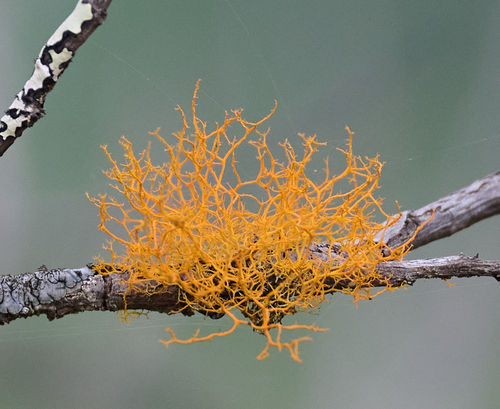Lichens: The ultimate symbiotic superorganisms
- Bryan Ramírez Castro

- Feb 18
- 3 min read
Updated: Feb 19
1. What are lichens? Beyond plant, fungus, or alga
Lichens are not single organisms but mutualistic partnerships between two (or more) distantly related life forms:
Mycobiont:
A fungus (usually an ascomycete, rarely a basidiomycete).
Photobiont:
A photosynthetic partner—either green algae (e.g., Trebouxia) or cyanobacteria (e.g., Nostoc), sometimes both.
This symbiosis is so integrated that lichens are classified as their own unique ecological entity. The fungal partner forms the majority of the lichen’s physical structure (the thallus), while the photobiont cells nestle within it, hidden from view.
2. The Symbiotic "Deal": Who Does What?
The partnership thrives on a division of labor:
Fungal Responsibilities (Mycobiont):
Structure & Protection:
The fungus weaves a protective mesh of hyphae (filaments) around the photobiont, shielding it from UV radiation, extreme temperatures, and desiccation.
Water & Mineral Absorption:
Fungal hyphae act like sponges, absorbing water and dissolved nutrients (e.g., nitrogen, phosphorus) from rain, dew, or even the air.
Chemical Warfare:
Produces lichen acids, unique secondary metabolites that deter herbivores, kill competing microbes, and break down rocks (bioerosion).
Photobiont’s Role (Algae/Cyanobacteria):
Photosynthesis:
The photobiont uses sunlight to produce carbohydrates (e.g., glucose, sugar alcohols), feeding both partners.
Nitrogen Fixation:
Cyanobacterial photobionts (in lichens like Peltigera) convert atmospheric nitrogen (N₂) into ammonia (NH₃), fertilizing ecosystems.
This mutual exchange is so efficient that lichens can thrive where neither partner could survive alone.
3. Anatomy of a Lichen: A Layered Survival Machine
Lichens have a stratified structure visible under microscopy:
Upper Cortex: A dense fungal layer blocking UV light.
Photobiont Layer: Algae/cyanobacteria embedded in loose hyphae for optimal light capture.
Medulla: A spongy fungal core storing water and minerals.
Lower Cortex/Rhizines: Root-like structures anchoring the lichen to surfaces (rocks, bark, soil).
Morphological Diversity:
Crustose: Paint-like crusts on rocks (e.g., Xanthoria).
Foliose: Leafy lobes (e.g., Lobaria).
Fruticose: Shrubby or hair-like growth (e.g., Usnea, “Old Man’s Beard”).
4. Survival Hacks: How Lichens Conquer Extreme Environments
Lichens are extremophiles, surviving in deserts, Arctic tundra, and toxic urban areas. Their secrets:
Poikilohydry: They have no roots or cuticle, so they desiccate completely when dry, entering suspended animation. Reactivate in seconds with water.
Sunscreen Chemistry: Fungal pigments (e.g., melanin, parietin) absorb harmful UV wavelengths.
Rock Dissolution: Lichen acids (e.g., oxalic acid) slowly dissolve minerals, releasing nutrients and pioneering soil formation.
5. Reproduction: Teamwork Makes the Dream Work
Lichens reproduce in two ways:
Sexual (Fungal): The mycobiont produces spores (e.g., in apothecia). If a spore lands near a compatible photobiont, a new lichen forms. Risky—like a fungal “blind date.”
Asexual Clones:
Soredia: Powdery bundles of fungal hyphae + photobiont cells, dispersed by wind.
Isidia: Tiny outgrowths that break off.
6. Ecological Roles: Lichens Rule the World (Quietly)
Pioneer Species: Colonize bare rock, kickstarting soil formation via bioerosion.
Bioindicators: Hyper-sensitive to air pollution (e.g., sulfur dioxide). Absence of lichens = poor air quality.
Nitrogen Fixers: Lichens with cyanobacteria (e.g., Peltigera) fertilize nutrient-poor ecosystems.
Wildlife Food: Reindeer moss (Cladonia) sustains Arctic herbivores; larvae of some moths rely entirely on lichens.
7. Human Uses: From Antibiotics to Perfumes
Historical Dyes: Orchil (purple) and litmus (pH indicator) from Roccella and Ochrolechia.
Antimicrobials: Usnic acid from Usnea fights bacteria; research explores lichen compounds for antibiotics.
Perfumery: Oakmoss (Evernia prunastri) adds earthy notes to fragrances.
Space Biology: Studied in ESA experiments for potential survival on Mars.
8. Evolutionary Oddity: A 400-Million-Year-Old Marriage
Fossil evidence suggests lichens existed 400 MYA, aiding plant colonization of land. Genetic studies reveal some fungal lineages evolved dependency on photobionts, losing the ability to live solo. But is it true mutualism? Some argue the fungus “enslaves” the photobiont by penetrating its cells with haustoria (nutrient-siphoning structures).
Final Thoughts: Lichens as a Model for Collaboration
Lichens challenge our view of individuality. They’re a testament to the power of collaboration—a fusion of kingdoms that unlocks survival in places life “shouldn’t” exist. Next time you see a lichen, remember: it’s a miniature world, built on ancient teamwork.




Comments